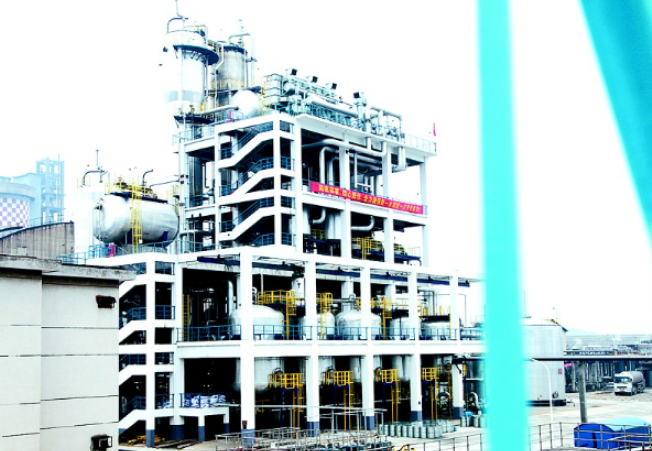Hydrogen peroxide (H2O2) is a versatile chemical compound known for its various applications, from acting as a disinfectant to being used in industrial processes. Understanding the methods of preparing hydrogen peroxide sheds light on the intricate chemical processes involved in its production. In this article, we delve into the different approaches to synthesizing hydrogen peroxide, exploring both historical and modern methods.
The electrolysis of 30 percent ice-cold H₂SO₄ produces hydrogen peroxide. An acidified sulphate solution is electrolyzed at a high current density to create peroxodisulphate. Hydrogen peroxide is produced when peroxodisulphate is hydrolyzed. At room temperature, it is a colourless liquid with a harsh flavour.

Hydrogen Peroxide Plant (Fixed Bed Process)
Historical Methods of Hydrogen Peroxide Synthesis
Barium Peroxide and Sulfuric Acid Reaction
One of the earliest methods of hydrogen peroxide synthesis involved the reaction between barium peroxide (BaO2) and sulfuric acid (H2SO4). The reaction can be represented as follows:
BaO2 + H2SO4 → BaSO4 + H2O2
While this method laid the foundation for hydrogen peroxide production, it had significant drawbacks. The separation of barium sulfate (BaSO4) from the hydrogen peroxide produced was challenging, making the process inefficient and costly.
Modern Methods of Hydrogen Peroxide Synthesis
Anthraquinone Process
The anthraquinone process is a widely used industrial method for the large-scale production of hydrogen peroxide. It involves the following steps:
1. Hydrogenation of Anthraquinone: Anthraquinone is hydrogenated to form 1,4-dihydroxyanthraquinone.
2. Oxidation: The 1,4-dihydroxyanthraquinone is then oxidized using air to produce hydrogen peroxide and regenerate anthraquinone.
3. Extraction: Hydrogen peroxide is extracted from the reaction mixture, resulting in a solution of the compound.
The anthraquinone process is efficient and allows for continuous production on an industrial scale. However, it requires specialized equipment and involves complex chemical reactions.
Autoxidation of 2-Ethyl Anthraquinone
In this method, 2-ethyl anthraquinone is oxidized by air to produce hydrogen peroxide. The process involves the following steps:
1. Hydrogenation: 2-ethyl anthraquinone is hydrogenated to produce 2-ethyl anthrahydroquinone.
2. Oxidation: The 2-ethyl anthrahydroquinone is then oxidized by air, generating hydrogen peroxide and regenerating 2-ethyl anthraquinone.
This method is favored for its efficiency and ability to produce high concentrations of hydrogen peroxide. It is often used in conjunction with the anthraquinone process to enhance overall production efficiency.
Laboratory Methods of Hydrogen Peroxide Synthesis
Barium Peroxide and Hydrogen Peroxide Reaction
In a laboratory setting, a direct reaction between barium peroxide and hydrogen peroxide can be employed. The reaction can be represented as follows:
BaO2 + H2O2 → Ba(OH)2 + O2
While this method is straightforward, it is not commonly used on an industrial scale due to the difficulties associated with separating barium hydroxide (Ba(OH)2) from the reaction mixture.
Electrolysis of Dilute Sulfuric Acid
In the laboratory, hydrogen peroxide can be synthesized through the electrolysis of dilute sulfuric acid (H2SO4). The process involves the following steps:
1. Electrolysis: Dilute sulfuric acid is electrolyzed to produce hydrogen ions (H+) and sulfate ions (SO4^2-).
2. Oxygen Evolution: At the anode, oxygen gas (O2) is evolved.
3. Hydrogen Peroxide Formation: Hydrogen ions react with oxygen at the cathode to form hydrogen peroxide.
While this method is suitable for laboratory-scale production, it is not commonly employed in large-scale industrial settings.
Challenges in Hydrogen Peroxide Synthesis
Despite advancements in production methods, there are challenges associated with the synthesis of hydrogen peroxide. The compound is prone to decomposition, and its concentration needs to be carefully controlled to avoid hazards. Additionally, the purification and separation processes can be complex and energy-intensive.
Safety Considerations and Storage
Hydrogen peroxide is a strong oxidizing agent and can be hazardous if mishandled. Proper safety precautions must be taken during its production, storage, and transportation. It is often stored in brown bottles to prevent decomposition caused by exposure to light.
Conclusion
Understanding the methods of preparing hydrogen peroxide provides insights into the diverse chemical processes involved in its synthesis. From historical methods using barium peroxide to modern industrial processes like the anthraquinone method, each approach has its advantages and challenges. Laboratory methods, while not scalable for industrial use, contribute to our understanding of the compound's chemical properties.
For more information on hydrogen peroxide or to explore options as a chemical supplier, feel free to contact us. Our team of experts is ready to assist with any inquiries or provide guidance on the safe handling and applications of hydrogen peroxide in various industries.
















